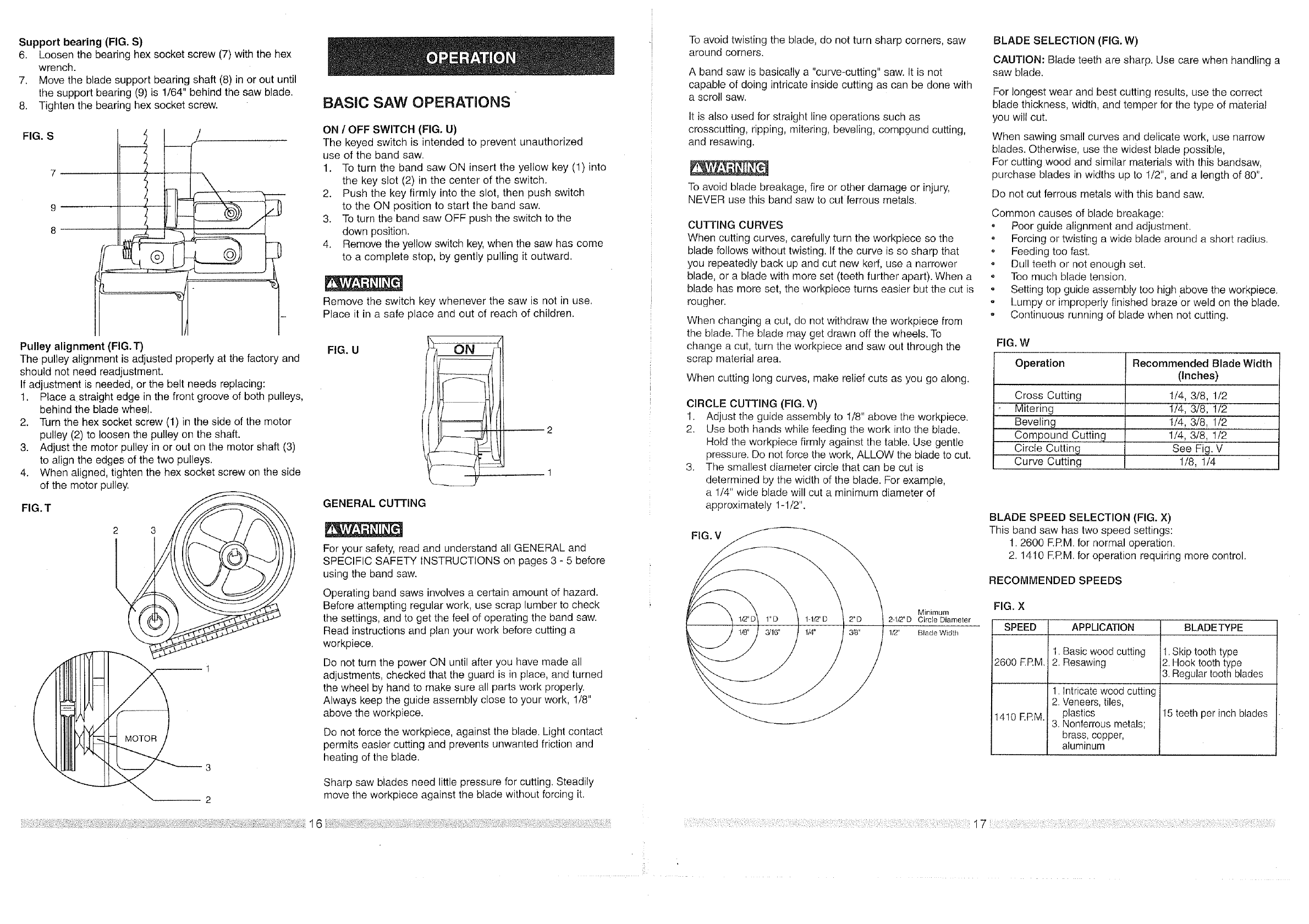
Support bearing (FIG. S)
6. Loosen the bearing hex socket screw (7) with the hex
wrench.
7. Move the blade support bearing shaft (8) in or out until
the support bearing (9) is 1/64" behind the saw blade.
8. Tighten the bearing hex socket screw.
BASIC SAW OPERATIONS
FIG. S
9
8
ON / OFF SWITCH (FIG. U)
The keyed switch is intended to prevent unauthorized
use of the band saw.
1. To turn the band saw ON insert the yellow key (1) into
the key slot (2) in the center of the switch.
2. Push the key firmly into the slot, then push switch
to the ON position to start the band saw.
3. To turn the band saw OFF push the switch to the
down position.
4. Remove the yellow switch key,when the saw has come
to a complete stop, by gently pulling it outward.
Remove the switch key whenever the saw is not in use.
Place it in a safe place and out of reach of children.
Pulley alignment (FIG.T)
The pulley alignment is adjusted properly at the factory and
should not need readjustment.
If adjustment is needed, or the belt needs replacing:
1. Place a straight edge in the front groove of both pulleys,
behind the blade wheel
2. Turn the hex socket screw (1) in the side of the motor
pulley (2) to loosen the pulley on the shaft.
3. Adjust the motor pulley in or out on the motor shaft (3)
to align the edges of the two pulleys.
4. When aligned, tighten the hex socket screw on the side
of the motor pulley.
FIG. T
FIG. U
l ON
GENERAL CUTTING
For your safety, read and understand all GENERAL and
SPECIFIC SAFETY INSTRUCTIONS on pages 3 - 5 before
using the band saw.
Operating band saws involves a certain amount of hazard.
Before attempting regular work, use scrap lumber to check
the settings, and to get the feel of operating the band saw.
Read instructions and plan your work before cutting a
workpiece.
Do not turn the power ON until after you have made all
adjustments, checked that the guard is in place, and turned
the wheel by hand to make sure all parts work properly.
Always keep the guide assembly close to your work, 1/8"
above the workpiece.
Do not force the workpiece, against the blade. Light contact
permits easier cutting and prevents unwanted friction and
heating of the blade.
Sharp saw biades need little pressure for cutting. Steadily
move the workpiece against the blade without forcing it.
16 :
To avoid twisting the blade, do not turn sharp corners, saw
around corners.
A band saw is basically a "curve-cutting" saw. It is not
capable of doing intricate inside cutting as can be done with
a scroll saw.
It is also used for straight line operations such as
crosscutting, ripping, mitering, beveling, compound cutting,
and resawing.
To avoid blade breakage, fire or other damage or injury,
NEVER use this band saw to cut ferrous metals.
CUTTING CURVES
When cutting curves, carefully turn the workpiece so the
blade follows without twisting. If the curve is so sharp that
you repeatedly back up and cut new kerr, use a narrower
blade, or a blade with more set (teeth further apart). When a
blade has more set, the workpiece turns easier but the cut is
rougher.
When changing a cut, do not withdraw the workpiece from
the blade. The blade may get drawn off the wheels. To
change a cut, turn the workpiece and saw out through the
scrap material area.
When cutting long curves, make relief cuts as you go along.
CIRCLE CUTTING (FIG. V)
1. Adjust the guide assembly to 1/8" above the workpiece.
2. Use both hands while feeding the work into the blade.
Hold the workpiece firmly against the table. Use gentle
pressure. Do not force the work, ALLOW the blade to cut.
3. The smallest diameter circle that can be cut is
determined by the width of the blade. For example,
a 1/4" wide blade will cut a minimum diameter of
approximately 1-1/2".
FIG. V
Minimum
2-1/Z'D Circle Diameter
1/2" Blade Width
BLADE SELECTION (FIG. W)
CAUTION: Blade teeth are sharp. Use care when handling a
saw blade.
For longest wear and best cutting results, use the correct
blade thickness, width, and temper for the type of material
you will cut.
When sawing small curves and delicate work, use narrow
blades. Otherwise, use the widest blade possible,
For cutting wood and similar materials with this bandsaw,
purchase blades in widths up to 1/2", and a length of 80".
Do not cut ferrous metals with this band saw.
Common causes of blade breakage:
• Poor guide alignment and adjustment.
o Forcing or twisting a wide blade around a short radius.
• Feeding too fast.
Dull teeth or not enough set.
Too much blade tension.
o Setting top guide assembly too high .above the workpiece.
- Lumpy or improperly finished braze or weld on the blade.
Continuous running of blade when not cutting.
FIG. W
Operation
Cross Cutting
Mitering
Beveling
Compound Cutting
Circle Cutting
Curve Cutting
Recommended Blade Width
(Inches)
1/4, 3/8, 1/2
1/4, 3/8, 1/2
1/4, 3/8, 1/2
1/4, 3/8, 1/2
See Fig. V
1/8, 1/4
BLADE SPEED SELECTION (FIG. X)
This band saw has two speed settings:
1. 2600 RRM. for normal operation.
2. 1410 RRM. for operation requiring more control.
RECOMMENDED SPEEDS
FIG. X
SPEED APPLICATION BLADETYPE
1.Basic wood cutting 1.Skip tooth type
2600 KRM. 2. Resawing 2.Hook tooth type
3.Regular tooth blades
1410 RRM. 15 teeth per inch blades
1.Intricatewood cutting
2.Veneers, tiles,
plastics
3. Nonferrous metals;
brass, copper,
aluminum
17
















